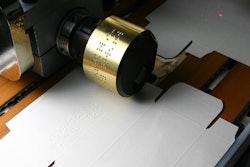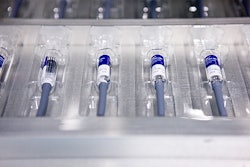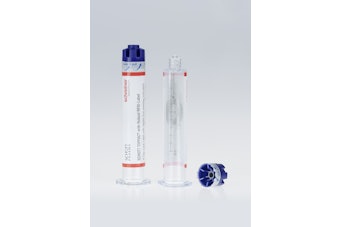Consistently and continually delivering compliant, safe, successful blister sealing builds trust and provides the confidence needed in a partnership between a contract packager and pharmaceutical company. The following tips can assist these groups in developing a more successful bond:
Tip 1: Avoiding common sealing pitfalls
Common sealing risks include insufficient seal area around the blister cavity, inadequate sealing temperature for the materials used, inaccurate seal pressure, and customer surprises—say, a tablet coating or lubricant that can interfere with sealability to film or foil.
How do you avoid these? Start by getting your product team involved at the outset. Vendor purchasing, package development, manufacturing, customer, and packaging representatives need to understand the blister-manufacturing requirements and then define those in the technical transfer document. The packager should go over these with the customer to ensure understanding of how the product contributes to blister seal quality. Other pitfall prevention methods include: communicating tooling requirements with the tooling manufacturer to ensure adequate seal area between the cavity and the blister card edge (or perforations between sections); determining what sealing temperatures and pressures need to be during the Operational Qualification testing; and testing components for seal integrity—both with and without actual product—and then testing again. Don't forget to get vendors involved to help you—they are experts and can often offer free engineering assistance.
Tip 2: Validation compliance and sealing
Validation, when done correctly, can reduce setup time, decrease scrap, and increase yield because changes in seal-quality performance are more easily identified when the process is fully documented through validation.
Validation should include qualifying each combination of film, foil, and tooling. Operational Qualification will determine and verify operational ranges to ensure that the blister meets all physical and visual quality attributes. Blister cards should also be leak-tested to ensure seal integrity.
Additionally, thermoformer validation establishes documented evidence for the packager, pharmaceutical company, and regulatory agencies that the packager has established the correct equipment, tooling setup, and operational parameters that will consistently produce a blister card meeting all quality requirements.
Tip 3: Fitting sustainability and reduced energy use into sealing
The “greening” of blister sealing can mean a number of things. First, design blister cards that minimize film and foil requirements, yet achieve the requirements for seal area and product protection. Next and where possible, replace pneumatic cylinders with electric (servo) cylinders to reduce energy costs as they operate. Also, recycle materials used in setup and all scrap (minus product) that results from a packaging process.
Finally, remember to look for more energy-efficient materials that can seal successfully at lower temperatures.
Tip 4: The structural design process behind blisters
The structural design process begins with discussions and a close, symbiotic working relationship among the Packaging Development team, the Marketing Group, and Quality and Regulatory departments. Those initial discussions should center on determining the true goal of dispensing the product at the patient level while simultaneously ensuring that marketing and compliance objectives are met.
How the blister card is to be used and how it will be presented to the customer in the final package contribute to the design requirements. For example, will the finished product be for sample or trade? Will it be packaged in a carton, hang tab, or fold-over card? Will the seal area requirements mandate a perforation? Is cold-formed foil needed to protect the product? Is the product light-sensitive?
These questions and more will help determine sealing success. Remember, a successful product is one that is not only safe, secure, and compliant, but also is used as the therapy dictates and reminds the consumer if he's taken it or not. Those are the ones that will actually sell more products because they aid patient compliance and desired dosing and health results.
Tip 5: Personalizing and customizing packages for consumers
Blister package design must adequately protect the product from degradation over the product's shelf life while also differentiating the package to help build product branding and increase product stability.
For example, blister cards must be designed to ensure that the film material used will adequately protect the product from moisture, oxygen, and other external and environmental factors, while also differentiating the product from competitors by including important information that the consumer will value. The consumer will then remember the product and build faith and trust in the brand.
An innovatively designed package can actually result in a significant increase in product net sales for the pharmaceutical company.
-By Scott C. Garverick, Vice President of Sales, Carton Service-Packaging Insights
Scott Garverick is vice president of sales for Carton Service-Packaging Insights, a pharmaceutical contract packaging company that delivers turnkey contract and compliance packaging for mid-sized and virtual pharmaceutical and nutraceutical companies throughout North America.
Tip 1: Avoiding common sealing pitfalls
Common sealing risks include insufficient seal area around the blister cavity, inadequate sealing temperature for the materials used, inaccurate seal pressure, and customer surprises—say, a tablet coating or lubricant that can interfere with sealability to film or foil.
How do you avoid these? Start by getting your product team involved at the outset. Vendor purchasing, package development, manufacturing, customer, and packaging representatives need to understand the blister-manufacturing requirements and then define those in the technical transfer document. The packager should go over these with the customer to ensure understanding of how the product contributes to blister seal quality. Other pitfall prevention methods include: communicating tooling requirements with the tooling manufacturer to ensure adequate seal area between the cavity and the blister card edge (or perforations between sections); determining what sealing temperatures and pressures need to be during the Operational Qualification testing; and testing components for seal integrity—both with and without actual product—and then testing again. Don't forget to get vendors involved to help you—they are experts and can often offer free engineering assistance.
Tip 2: Validation compliance and sealing
Validation, when done correctly, can reduce setup time, decrease scrap, and increase yield because changes in seal-quality performance are more easily identified when the process is fully documented through validation.
Validation should include qualifying each combination of film, foil, and tooling. Operational Qualification will determine and verify operational ranges to ensure that the blister meets all physical and visual quality attributes. Blister cards should also be leak-tested to ensure seal integrity.
Additionally, thermoformer validation establishes documented evidence for the packager, pharmaceutical company, and regulatory agencies that the packager has established the correct equipment, tooling setup, and operational parameters that will consistently produce a blister card meeting all quality requirements.
Tip 3: Fitting sustainability and reduced energy use into sealing
The “greening” of blister sealing can mean a number of things. First, design blister cards that minimize film and foil requirements, yet achieve the requirements for seal area and product protection. Next and where possible, replace pneumatic cylinders with electric (servo) cylinders to reduce energy costs as they operate. Also, recycle materials used in setup and all scrap (minus product) that results from a packaging process.
Finally, remember to look for more energy-efficient materials that can seal successfully at lower temperatures.
Tip 4: The structural design process behind blisters
The structural design process begins with discussions and a close, symbiotic working relationship among the Packaging Development team, the Marketing Group, and Quality and Regulatory departments. Those initial discussions should center on determining the true goal of dispensing the product at the patient level while simultaneously ensuring that marketing and compliance objectives are met.
How the blister card is to be used and how it will be presented to the customer in the final package contribute to the design requirements. For example, will the finished product be for sample or trade? Will it be packaged in a carton, hang tab, or fold-over card? Will the seal area requirements mandate a perforation? Is cold-formed foil needed to protect the product? Is the product light-sensitive?
These questions and more will help determine sealing success. Remember, a successful product is one that is not only safe, secure, and compliant, but also is used as the therapy dictates and reminds the consumer if he's taken it or not. Those are the ones that will actually sell more products because they aid patient compliance and desired dosing and health results.
Tip 5: Personalizing and customizing packages for consumers
Blister package design must adequately protect the product from degradation over the product's shelf life while also differentiating the package to help build product branding and increase product stability.
For example, blister cards must be designed to ensure that the film material used will adequately protect the product from moisture, oxygen, and other external and environmental factors, while also differentiating the product from competitors by including important information that the consumer will value. The consumer will then remember the product and build faith and trust in the brand.
An innovatively designed package can actually result in a significant increase in product net sales for the pharmaceutical company.
-By Scott C. Garverick, Vice President of Sales, Carton Service-Packaging Insights
Scott Garverick is vice president of sales for Carton Service-Packaging Insights, a pharmaceutical contract packaging company that delivers turnkey contract and compliance packaging for mid-sized and virtual pharmaceutical and nutraceutical companies throughout North America.





















